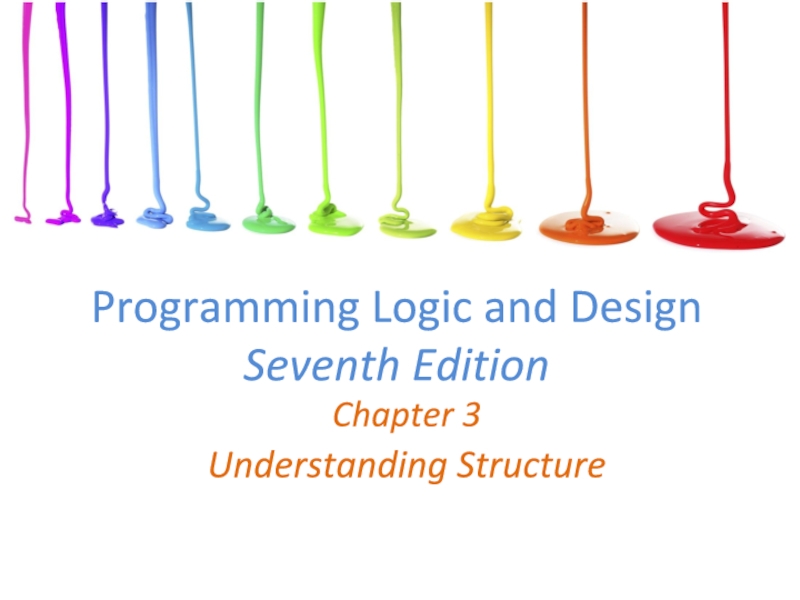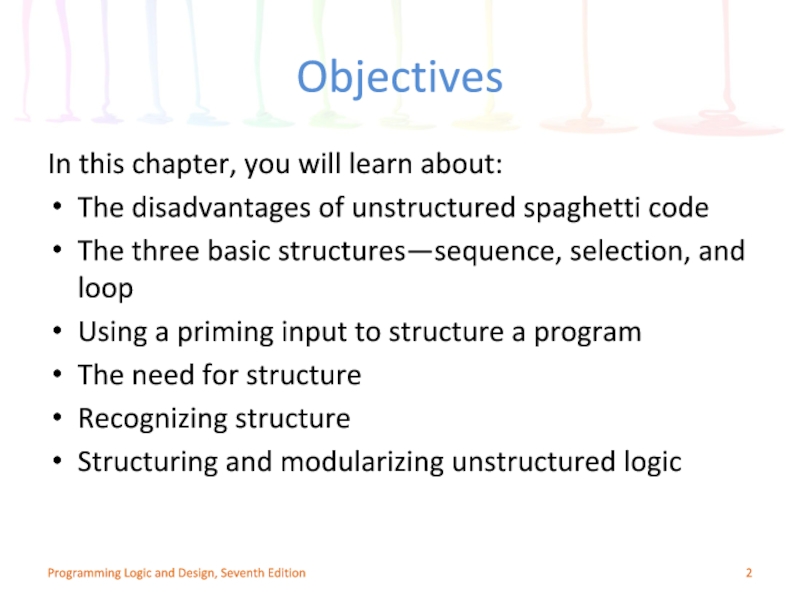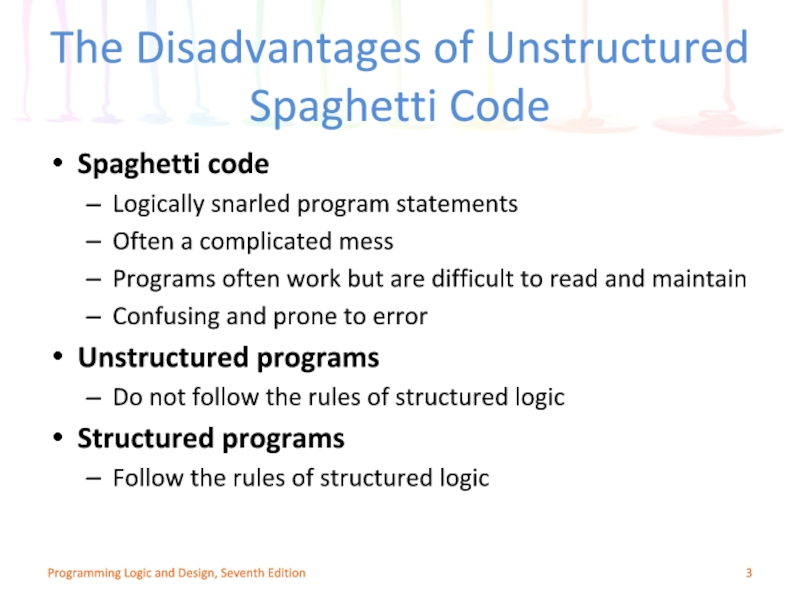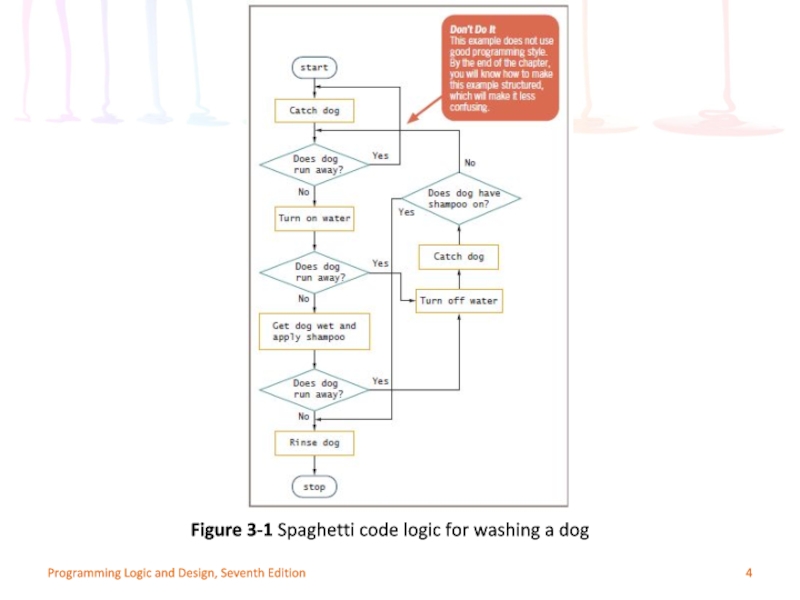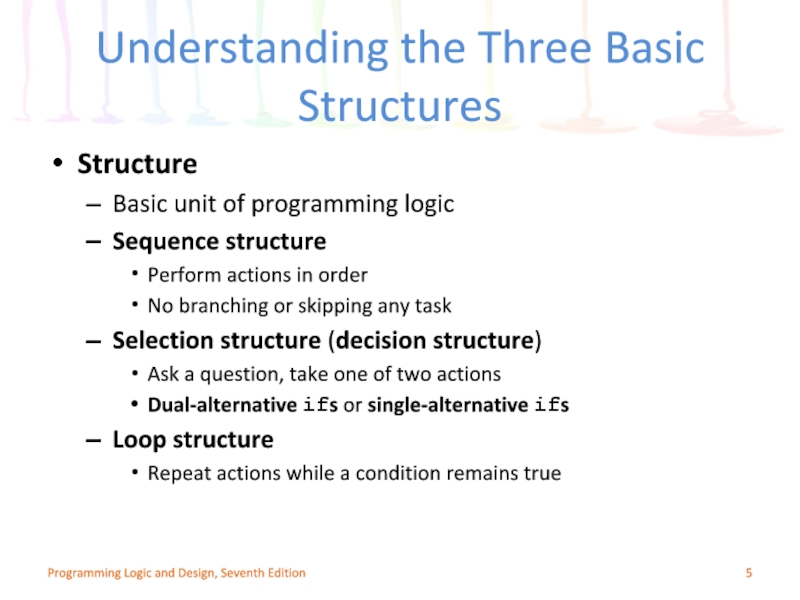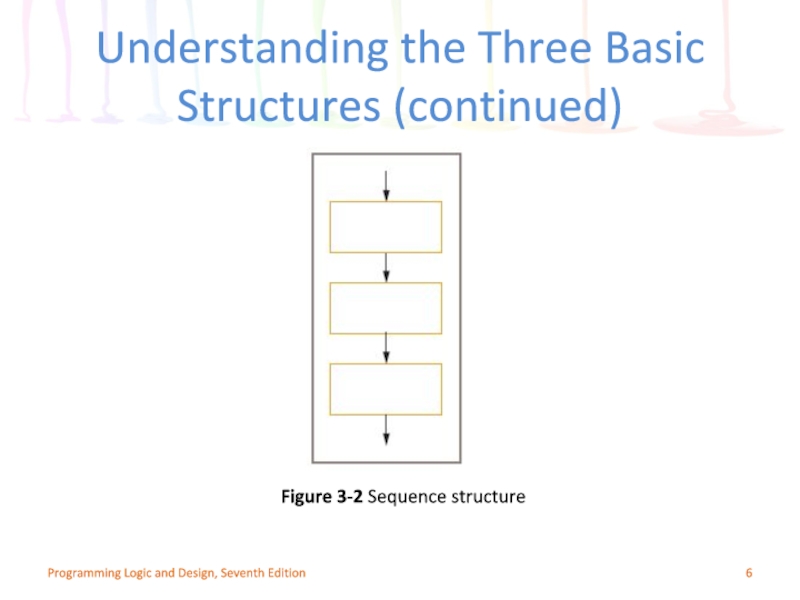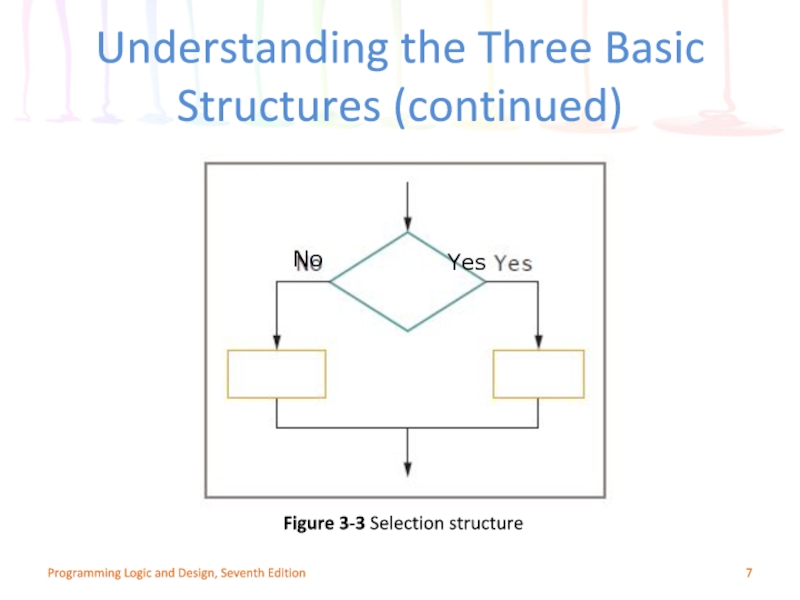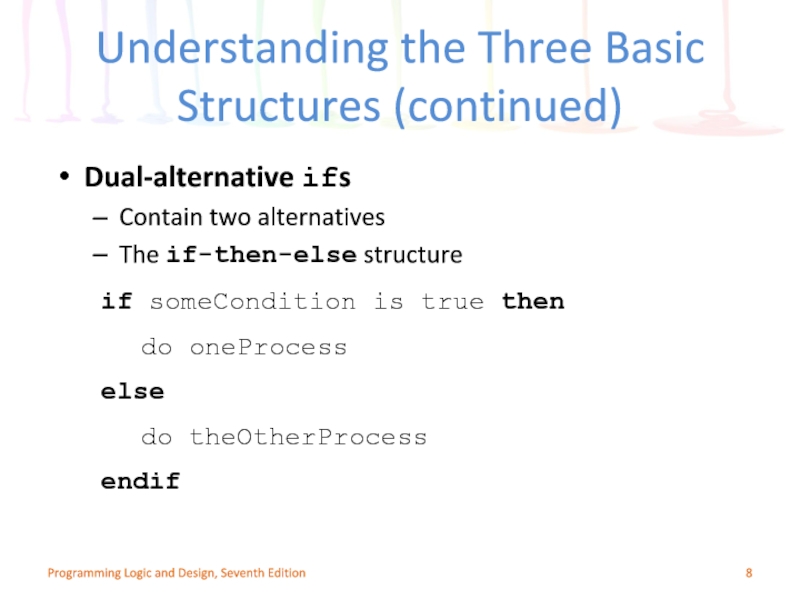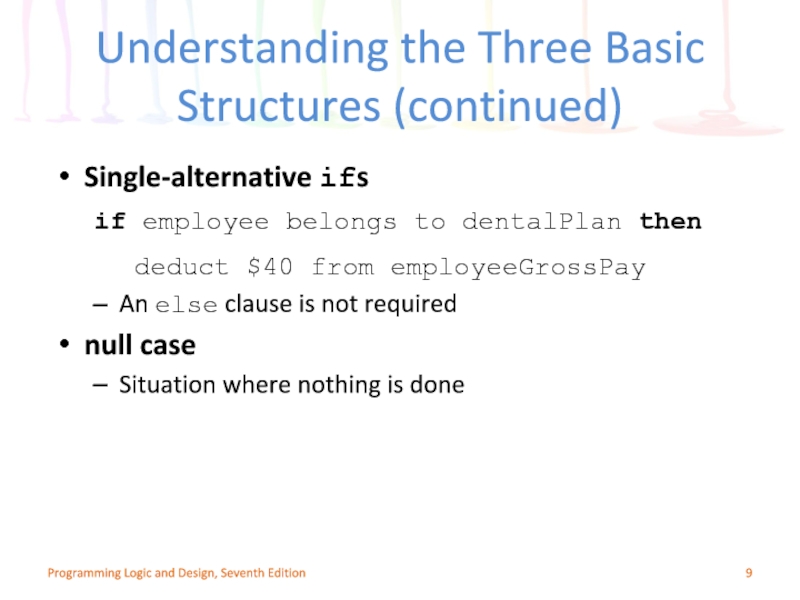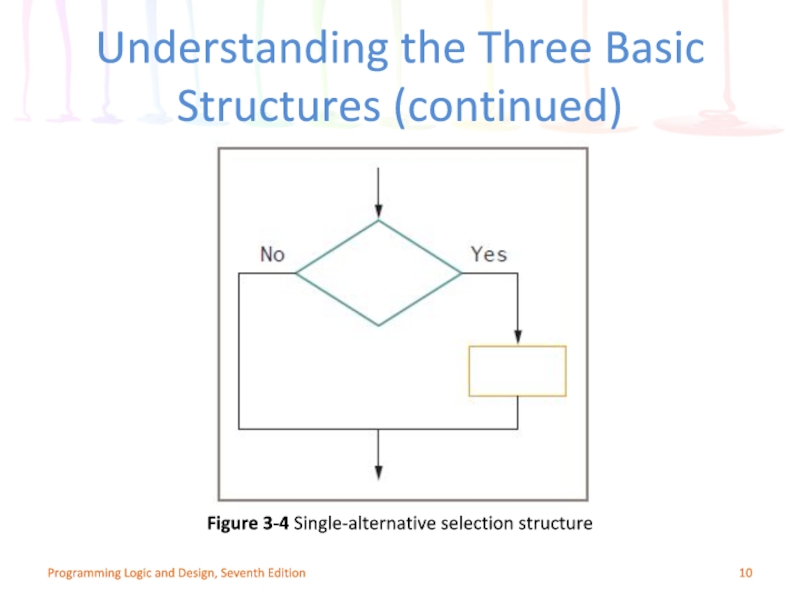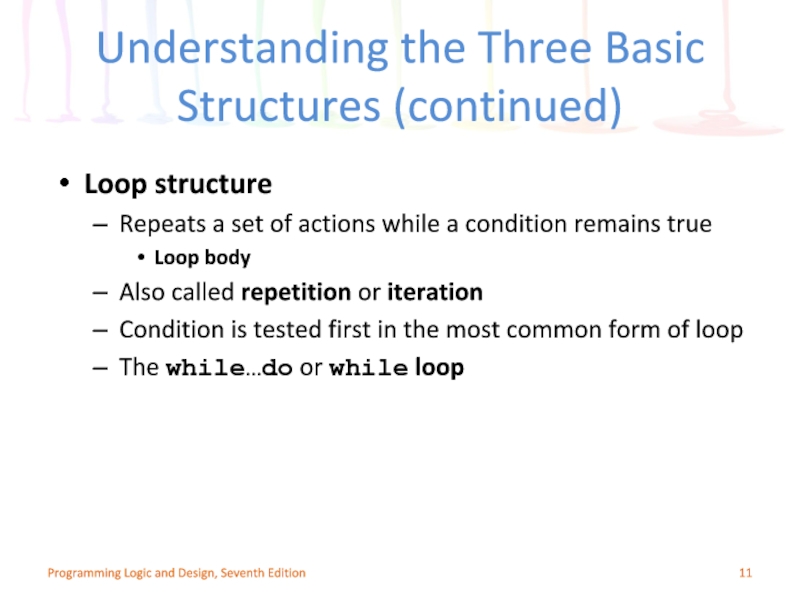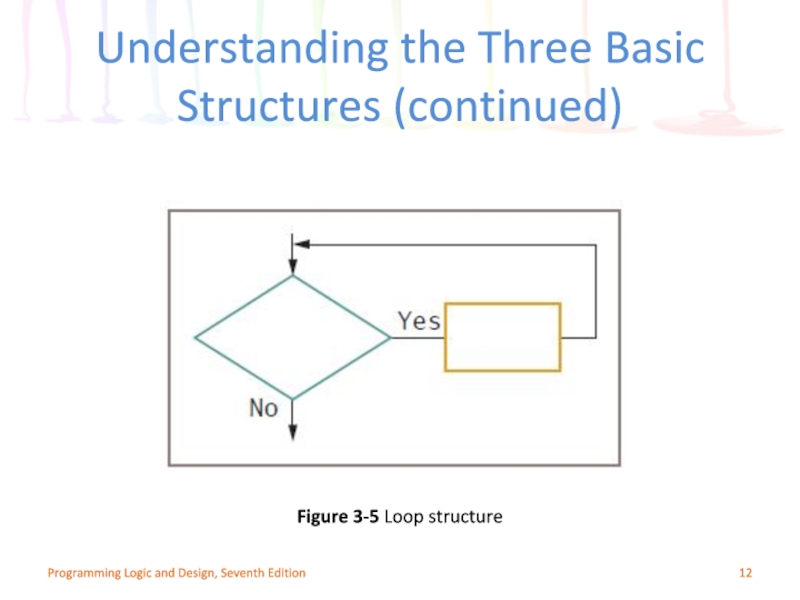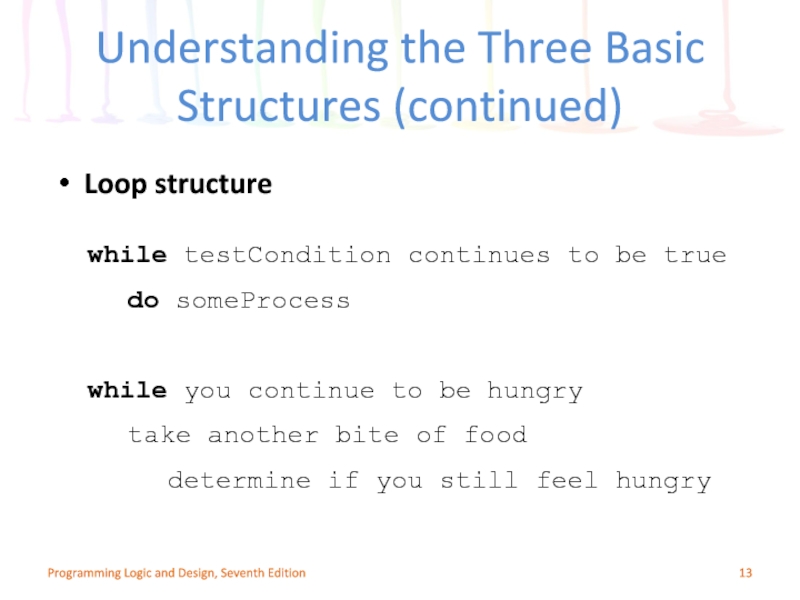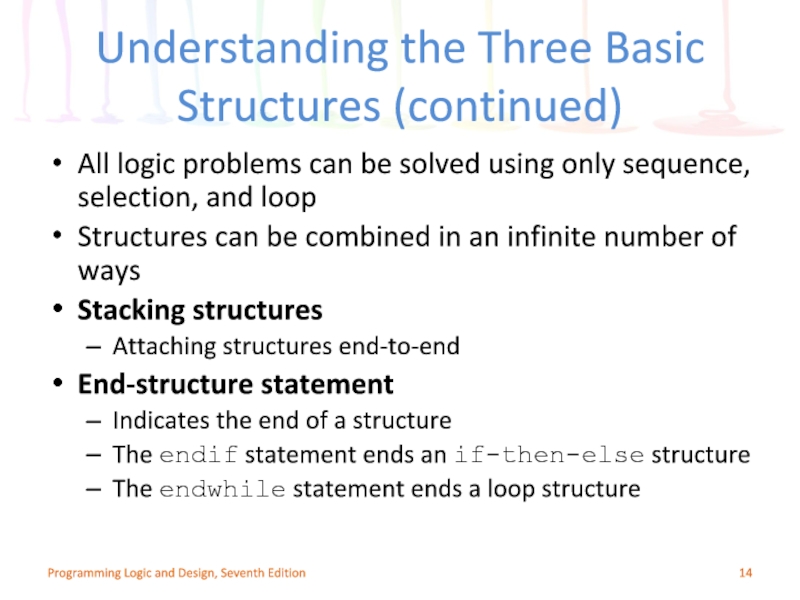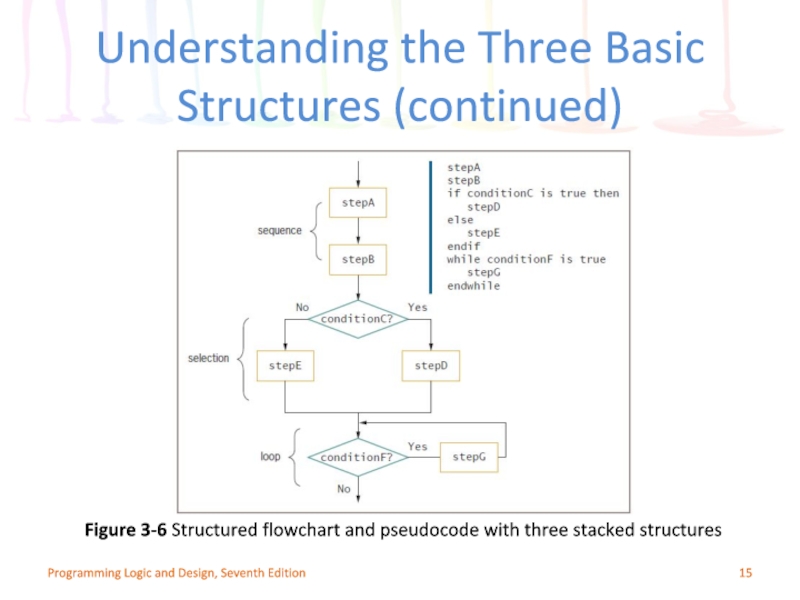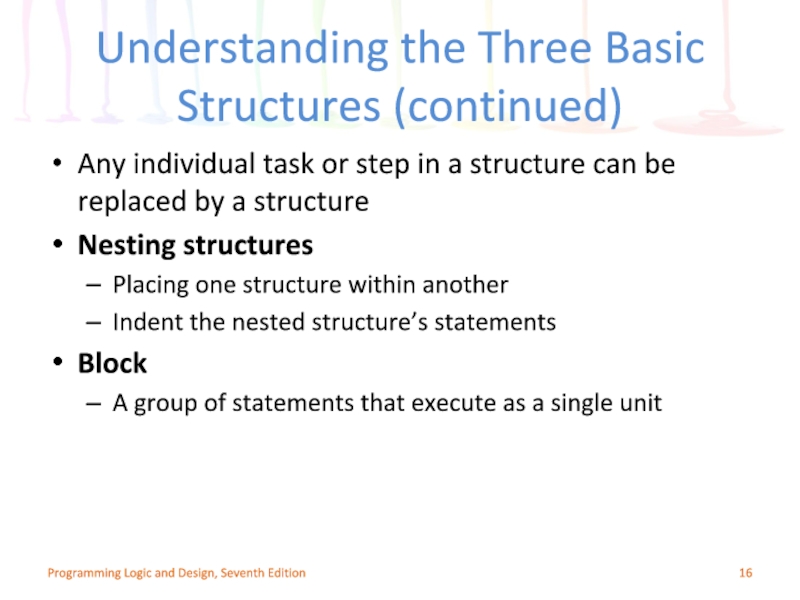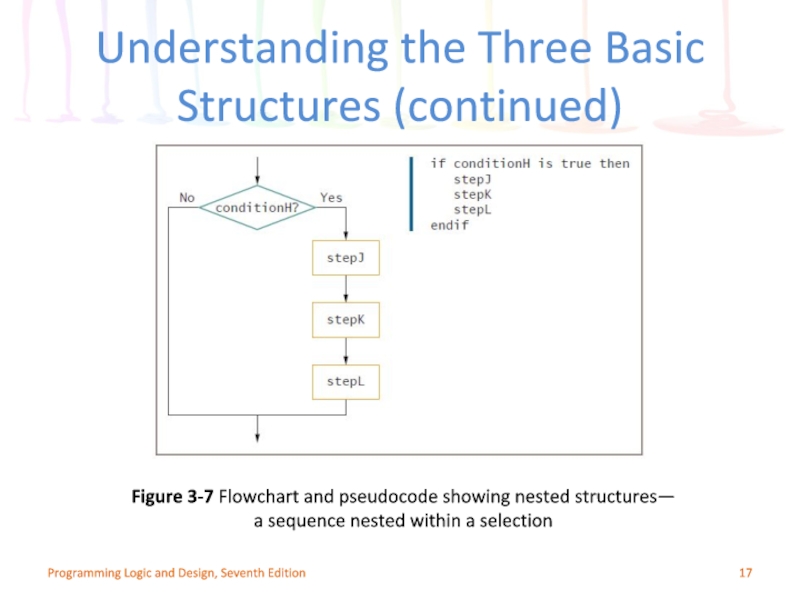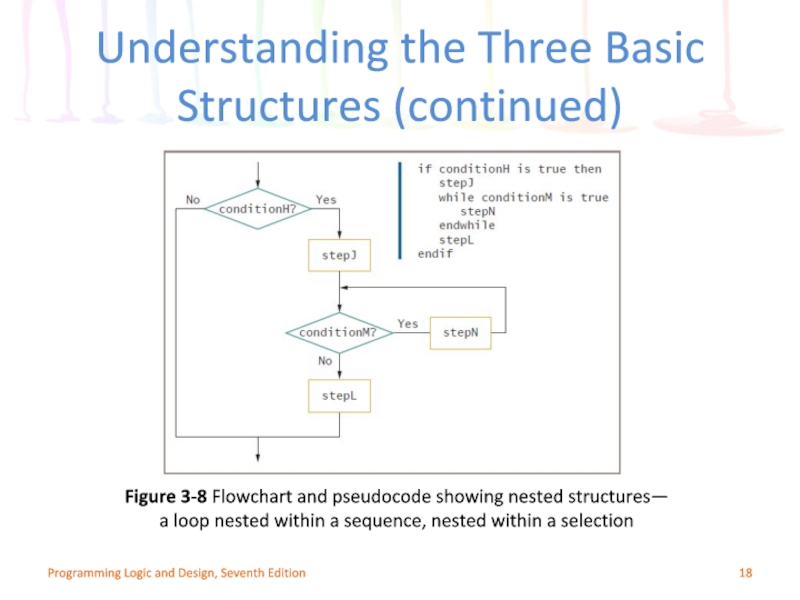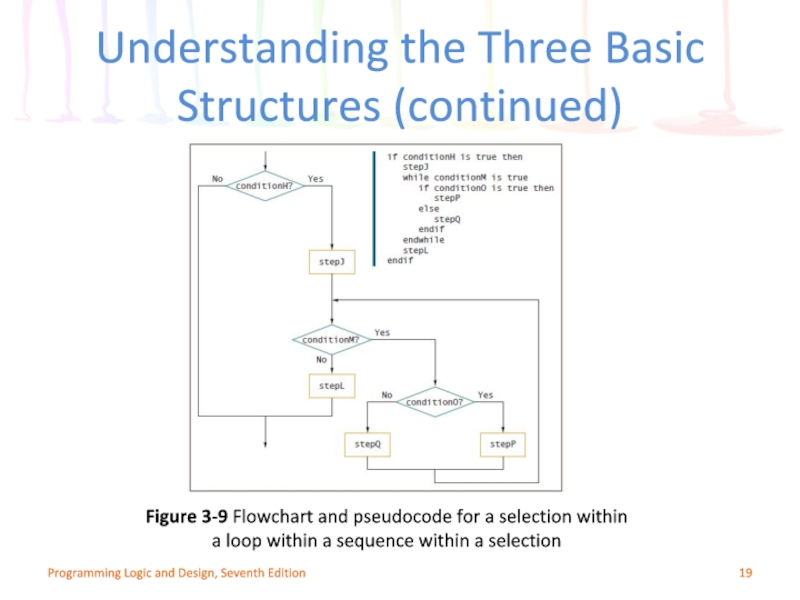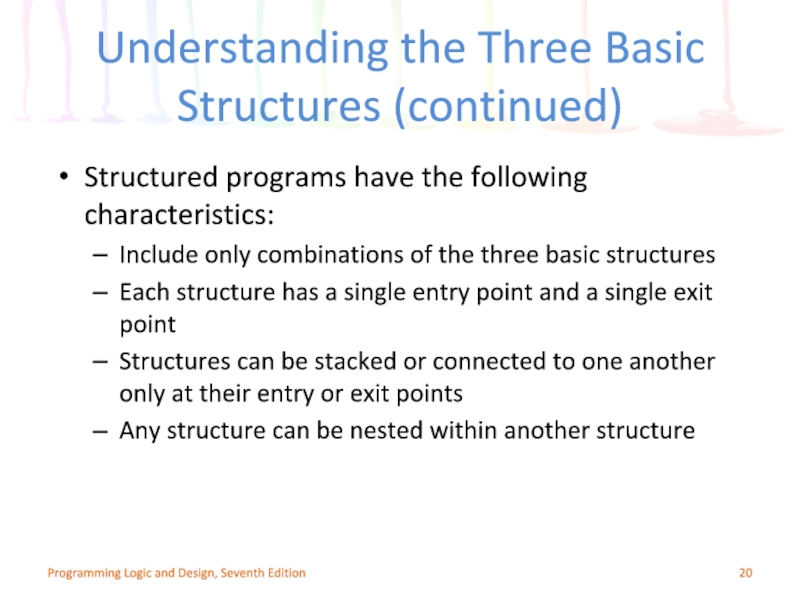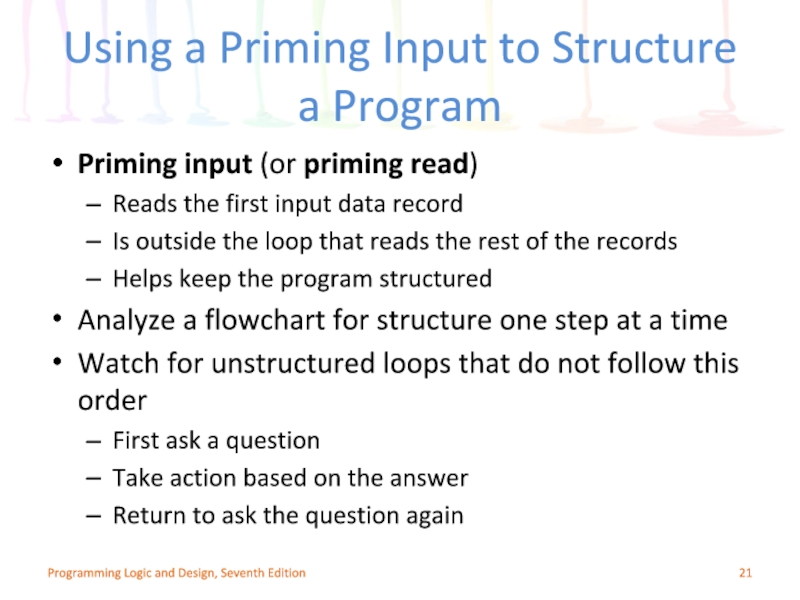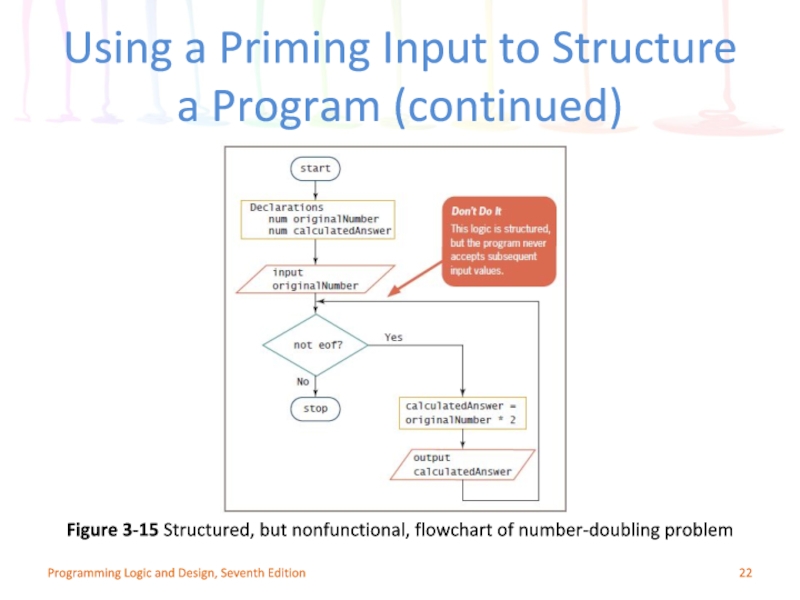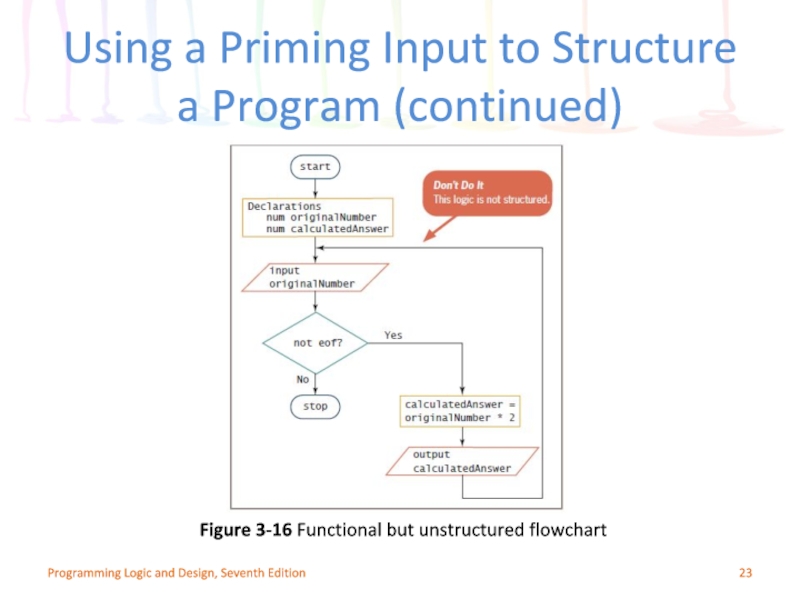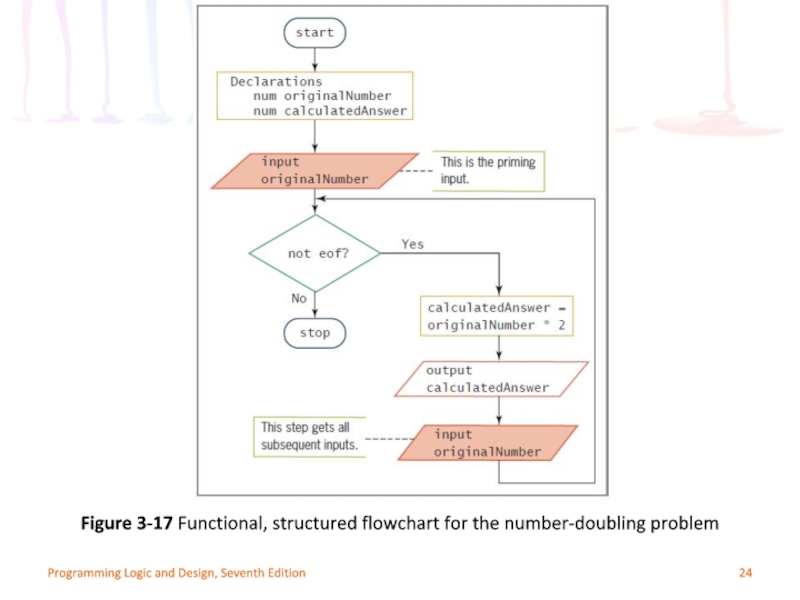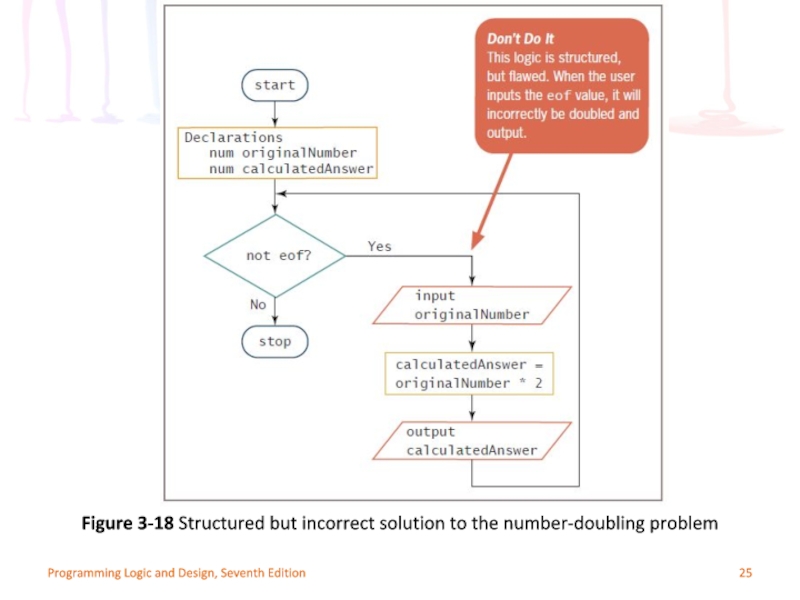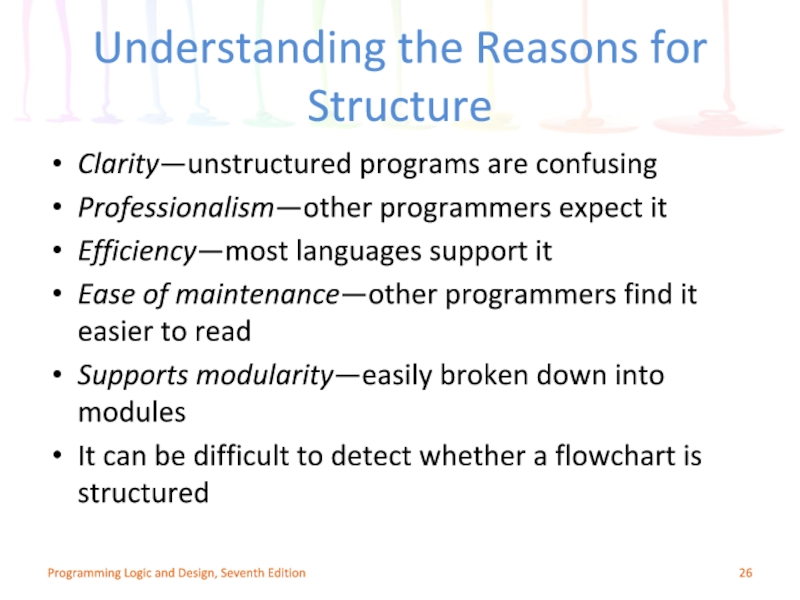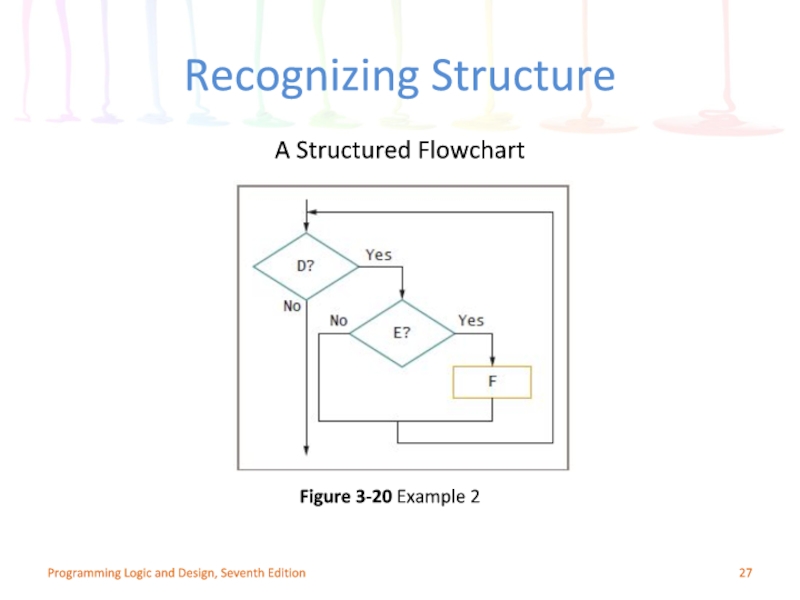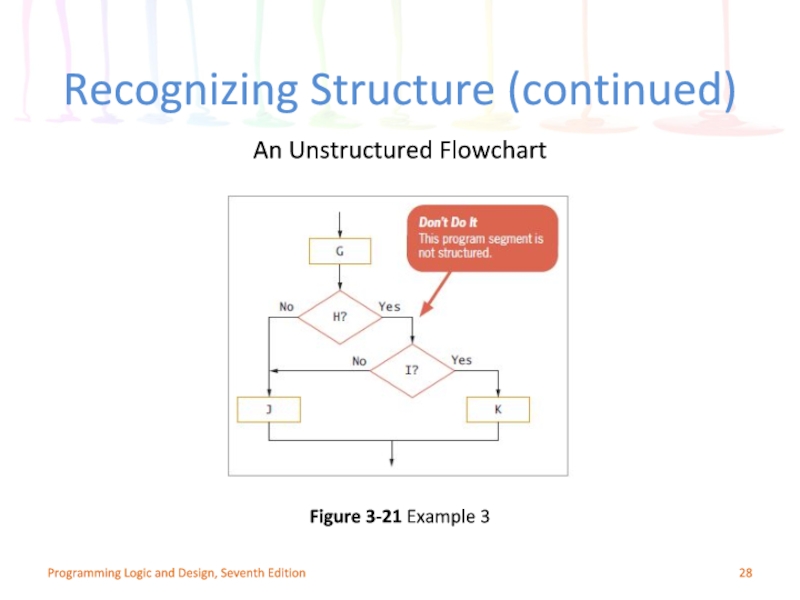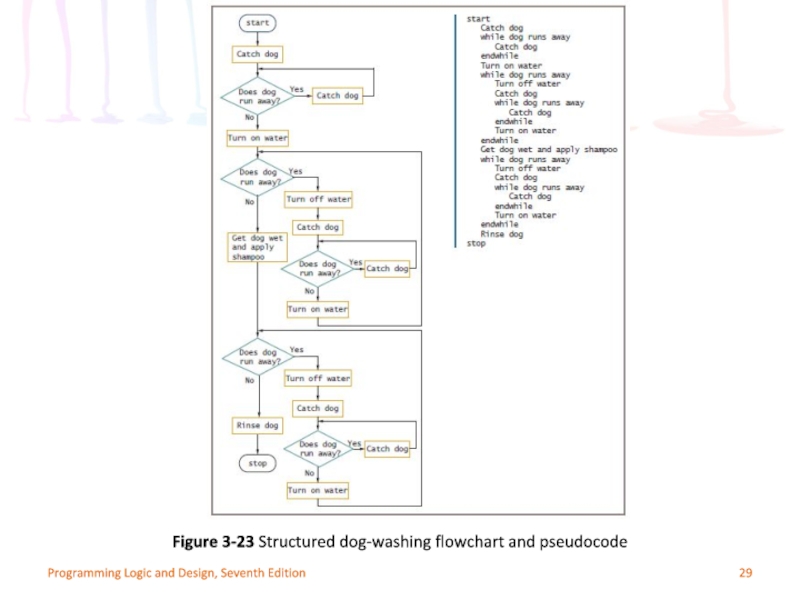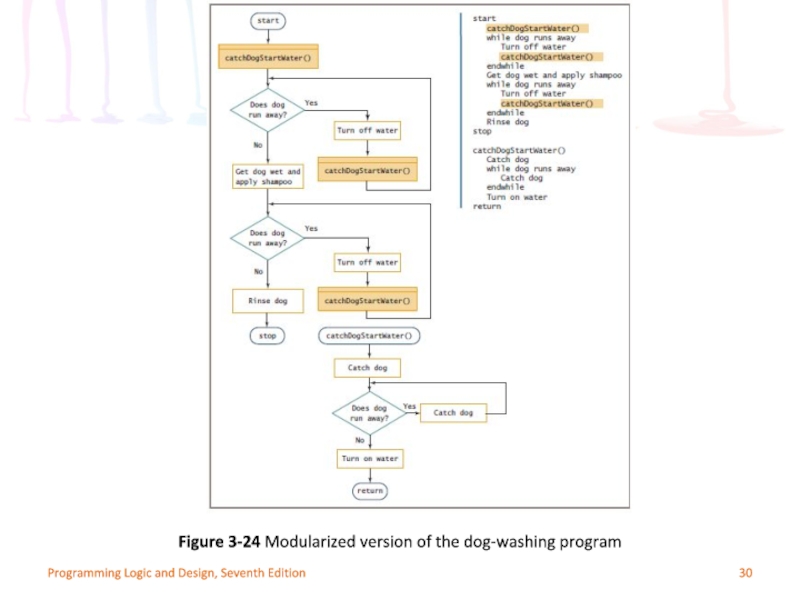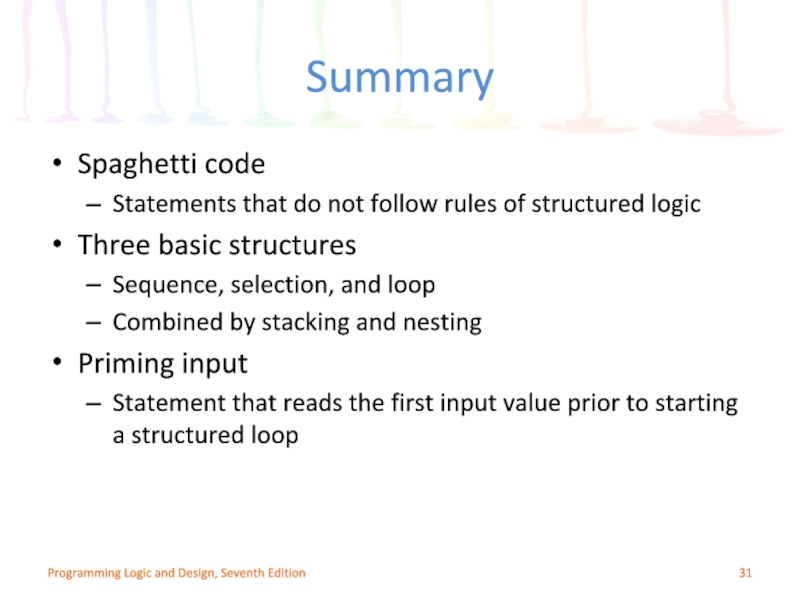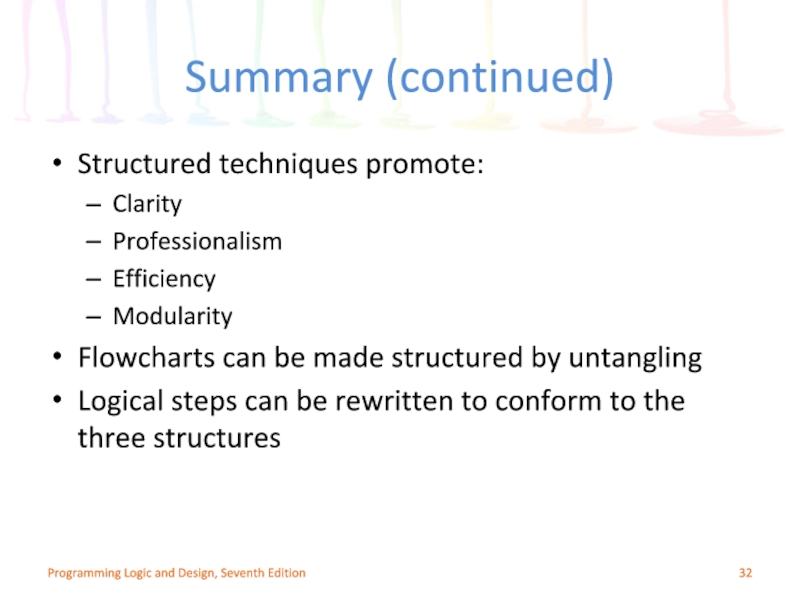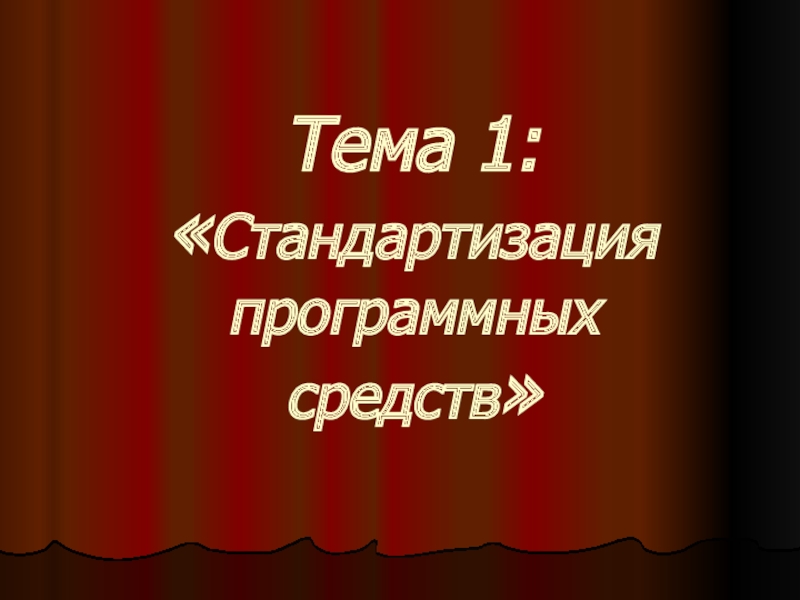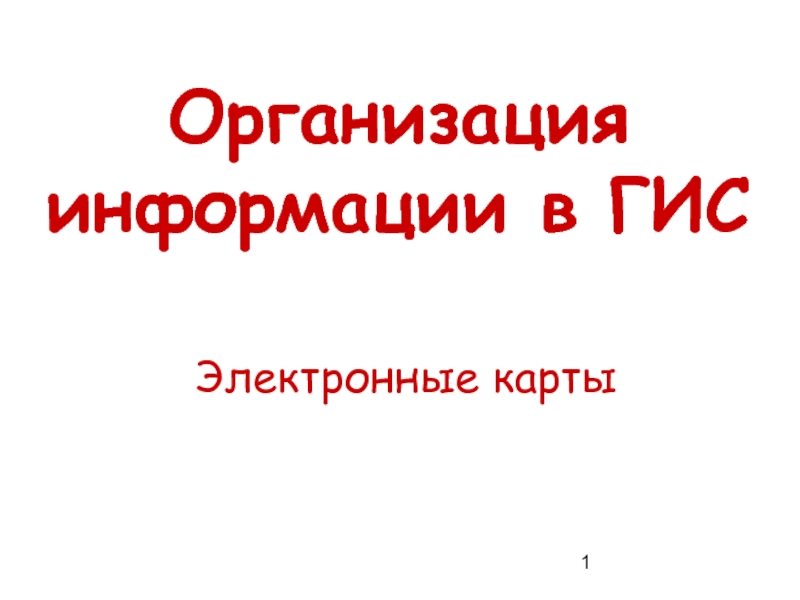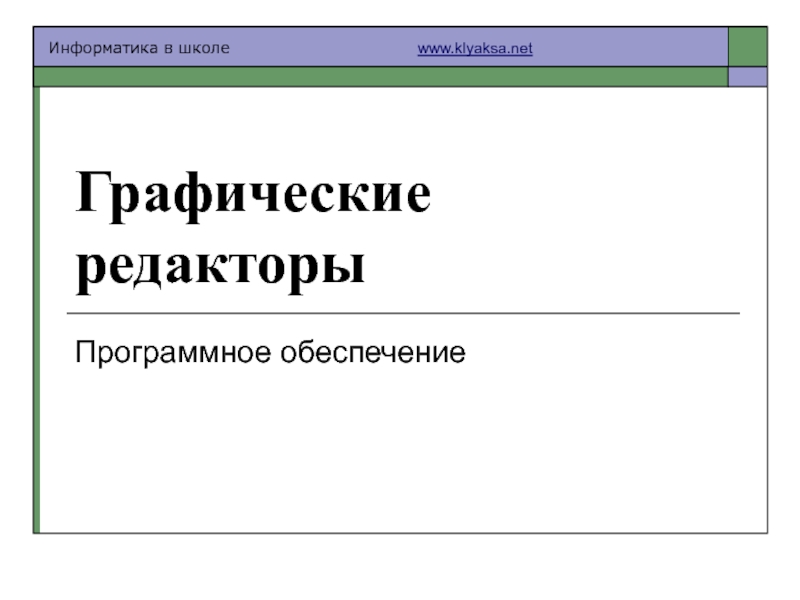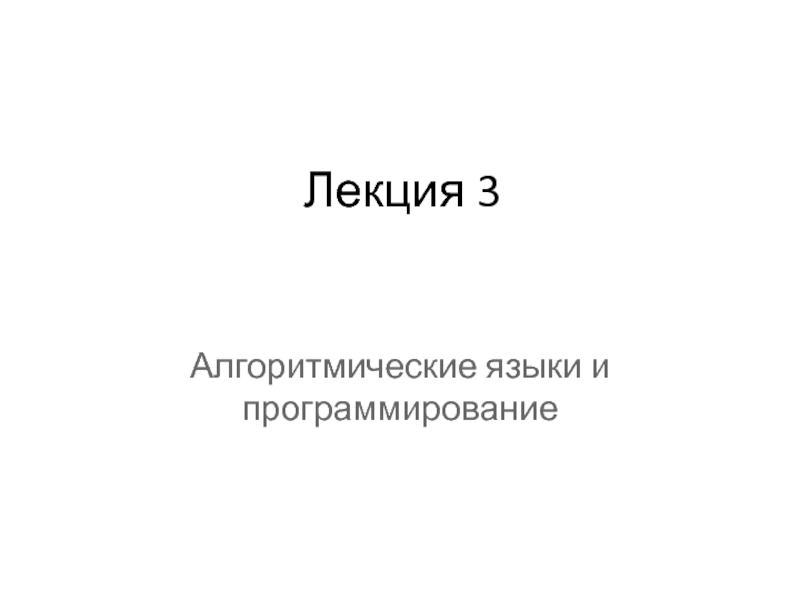- Главная
- Разное
- Дизайн
- Бизнес и предпринимательство
- Аналитика
- Образование
- Развлечения
- Красота и здоровье
- Финансы
- Государство
- Путешествия
- Спорт
- Недвижимость
- Армия
- Графика
- Культурология
- Еда и кулинария
- Лингвистика
- Английский язык
- Астрономия
- Алгебра
- Биология
- География
- Детские презентации
- Информатика
- История
- Литература
- Маркетинг
- Математика
- Медицина
- Менеджмент
- Музыка
- МХК
- Немецкий язык
- ОБЖ
- Обществознание
- Окружающий мир
- Педагогика
- Русский язык
- Технология
- Физика
- Философия
- Химия
- Шаблоны, картинки для презентаций
- Экология
- Экономика
- Юриспруденция
Programming Logic and Design, Seventh Edition презентация
Содержание
- 1. Programming Logic and Design, Seventh Edition
- 2. Objectives In this chapter, you will learn
- 3. The Disadvantages of Unstructured Spaghetti Code
- 4. Programming Logic and Design, Seventh Edition Figure 3-1 Spaghetti code logic for washing a dog
- 5. Understanding the Three Basic Structures Structure Basic
- 6. Understanding the Three Basic Structures (continued) Programming
- 7. Understanding the Three Basic Structures (continued) Programming
- 8. Understanding the Three Basic Structures (continued) Dual-alternative
- 9. Understanding the Three Basic Structures (continued) Single-alternative
- 10. Understanding the Three Basic Structures (continued) Programming
- 11. Understanding the Three Basic Structures (continued) Loop
- 12. Understanding the Three Basic Structures (continued) Programming
- 13. Understanding the Three Basic Structures (continued) Loop
- 14. Understanding the Three Basic Structures (continued) All
- 15. Understanding the Three Basic Structures (continued) Programming
- 16. Understanding the Three Basic Structures (continued) Any
- 17. Understanding the Three Basic Structures (continued) Programming
- 18. Understanding the Three Basic Structures (continued) Programming
- 19. Understanding the Three Basic Structures (continued) Programming
- 20. Understanding the Three Basic Structures (continued) Structured
- 21. Using a Priming Input to Structure a
- 22. Using a Priming Input to Structure a
- 23. Using a Priming Input to Structure a
- 24. Programming Logic and Design, Seventh Edition Figure 3-17 Functional, structured flowchart for the number-doubling problem
- 25. Programming Logic and Design, Seventh Edition Figure
- 26. Understanding the Reasons for Structure Clarity—unstructured programs
- 27. Programming Logic and Design, Seventh Edition Figure 3-20 Example 2 A Structured Flowchart Recognizing Structure
- 28. Recognizing Structure (continued) Programming Logic and Design,
- 29. Programming Logic and Design, Seventh Edition Figure 3-23 Structured dog-washing flowchart and pseudocode
- 30. Programming Logic and Design, Seventh Edition Figure 3-24 Modularized version of the dog-washing program
- 31. Summary Spaghetti code Statements that do not
- 32. Summary (continued) Structured techniques promote: Clarity
Слайд 2Objectives
In this chapter, you will learn about:
The disadvantages of unstructured spaghetti
The three basic structures—sequence, selection, and loop
Using a priming input to structure a program
The need for structure
Recognizing structure
Structuring and modularizing unstructured logic
Programming Logic and Design, Seventh Edition
Слайд 3The Disadvantages of Unstructured
Spaghetti Code
Spaghetti code
Logically snarled program statements
Often a
Programs often work but are difficult to read and maintain
Confusing and prone to error
Unstructured programs
Do not follow the rules of structured logic
Structured programs
Follow the rules of structured logic
Programming Logic and Design, Seventh Edition
Слайд 4Programming Logic and Design, Seventh Edition
Figure 3-1 Spaghetti code logic for
Слайд 5Understanding the Three Basic Structures
Structure
Basic unit of programming logic
Sequence structure
Perform
No branching or skipping any task
Selection structure (decision structure)
Ask a question, take one of two actions
Dual-alternative ifs or single-alternative ifs
Loop structure
Repeat actions while a condition remains true
Programming Logic and Design, Seventh Edition
Слайд 6Understanding the Three Basic Structures (continued)
Programming Logic and Design, Seventh Edition
Figure
Слайд 7Understanding the Three Basic Structures (continued)
Programming Logic and Design, Seventh Edition
Figure
No
Yes
Слайд 8Understanding the Three Basic Structures (continued)
Dual-alternative ifs
Contain two alternatives
The if-then-else structure
Programming
if someCondition is true then
do oneProcess
else
do theOtherProcess
endif
Слайд 9Understanding the Three Basic Structures (continued)
Single-alternative ifs
An else clause is not
null case
Situation where nothing is done
Programming Logic and Design, Seventh Edition
if employee belongs to dentalPlan then
deduct $40 from employeeGrossPay
Слайд 10Understanding the Three Basic Structures (continued)
Programming Logic and Design, Seventh Edition
Figure
Слайд 11Understanding the Three Basic Structures (continued)
Loop structure
Repeats a set of actions
Loop body
Also called repetition or iteration
Condition is tested first in the most common form of loop
The while…do or while loop
Programming Logic and Design, Seventh Edition
Слайд 12Understanding the Three Basic Structures (continued)
Programming Logic and Design, Seventh Edition
Figure
Слайд 13Understanding the Three Basic Structures (continued)
Loop structure
Programming Logic and Design, Seventh
while testCondition continues to be true
do someProcess
while you continue to be hungry
take another bite of food
determine if you still feel hungry
Слайд 14Understanding the Three Basic Structures (continued)
All logic problems can be solved
Structures can be combined in an infinite number of ways
Stacking structures
Attaching structures end-to-end
End-structure statement
Indicates the end of a structure
The endif statement ends an if-then-else structure
The endwhile statement ends a loop structure
Programming Logic and Design, Seventh Edition
Слайд 15Understanding the Three Basic Structures (continued)
Programming Logic and Design, Seventh Edition
Figure
Слайд 16Understanding the Three Basic Structures (continued)
Any individual task or step in
Nesting structures
Placing one structure within another
Indent the nested structure’s statements
Block
A group of statements that execute as a single unit
Programming Logic and Design, Seventh Edition
Слайд 17Understanding the Three Basic Structures (continued)
Programming Logic and Design, Seventh Edition
Figure
Слайд 18Understanding the Three Basic Structures (continued)
Programming Logic and Design, Seventh Edition
Figure
a loop nested within a sequence, nested within a selection
Слайд 19Understanding the Three Basic Structures (continued)
Programming Logic and Design, Seventh Edition
Figure
a loop within a sequence within a selection
Слайд 20Understanding the Three Basic Structures (continued)
Structured programs have the following characteristics:
Include
Each structure has a single entry point and a single exit point
Structures can be stacked or connected to one another only at their entry or exit points
Any structure can be nested within another structure
Programming Logic and Design, Seventh Edition
Слайд 21Using a Priming Input to Structure
a Program
Priming input (or priming read)
Reads
Is outside the loop that reads the rest of the records
Helps keep the program structured
Analyze a flowchart for structure one step at a time
Watch for unstructured loops that do not follow this order
First ask a question
Take action based on the answer
Return to ask the question again
Programming Logic and Design, Seventh Edition
Слайд 22Using a Priming Input to Structure
a Program (continued)
Programming Logic and Design,
Figure 3-15 Structured, but nonfunctional, flowchart of number-doubling problem
Слайд 23Using a Priming Input to Structure
a Program (continued)
Programming Logic and Design,
Figure 3-16 Functional but unstructured flowchart
Слайд 24Programming Logic and Design, Seventh Edition
Figure 3-17 Functional, structured flowchart for
Слайд 25Programming Logic and Design, Seventh Edition
Figure 3-18 Structured but incorrect solution
Слайд 26Understanding the Reasons for Structure
Clarity—unstructured programs are confusing
Professionalism—other programmers expect it
Efficiency—most
Ease of maintenance—other programmers find it easier to read
Supports modularity—easily broken down into modules
It can be difficult to detect whether a flowchart is structured
Programming Logic and Design, Seventh Edition
Слайд 27Programming Logic and Design, Seventh Edition
Figure 3-20 Example 2
A Structured Flowchart
Recognizing
Слайд 28Recognizing Structure (continued)
Programming Logic and Design, Seventh Edition
Figure 3-21 Example 3
An
Слайд 29Programming Logic and Design, Seventh Edition
Figure 3-23 Structured dog-washing flowchart and
Слайд 30Programming Logic and Design, Seventh Edition
Figure 3-24 Modularized version of the
Слайд 31Summary
Spaghetti code
Statements that do not follow rules of structured logic
Three basic
Sequence, selection, and loop
Combined by stacking and nesting
Priming input
Statement that reads the first input value prior to starting a structured loop
Programming Logic and Design, Seventh Edition
Слайд 32Summary (continued)
Structured techniques promote:
Clarity
Professionalism
Efficiency
Modularity
Flowcharts can be made structured by untangling
Logical
Programming Logic and Design, Seventh Edition
